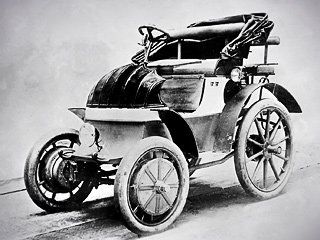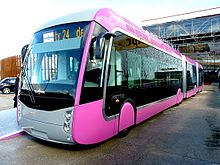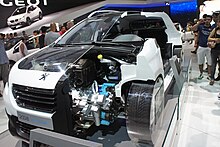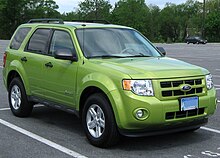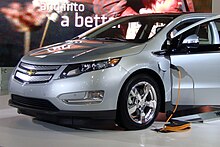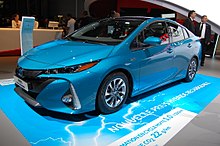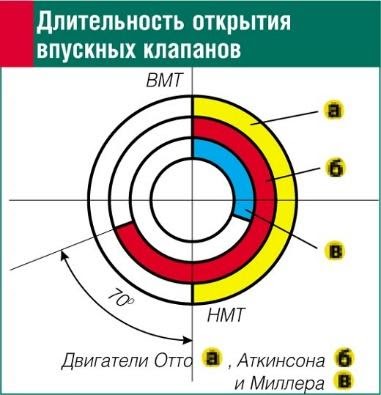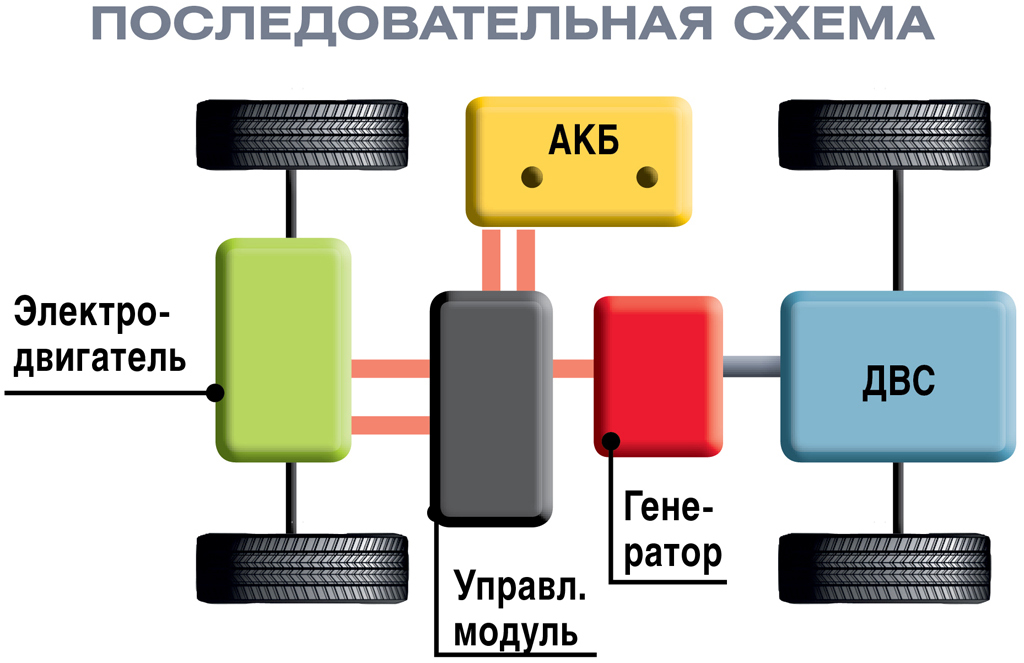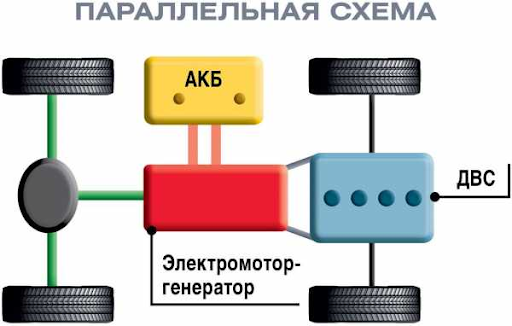Как устроены гибридные автомобили
|
|
Евгений Багдасаров, |
|
Первый в мире бензоэлектрический автомобиль Lohner Electric Chaise был создан Фердинандом Порше ещё в 1899 году. В 70-е годы XX века интерес к гибридам возобновился вследствие роста цен на топливо и ужесточения экологических норм. |
Гибридная силовая установка сочетает двигатель внутреннего сгорания и электромотор, что обеспечивает меньший расход топлива и снижает токсичность выхлопных газов. Однако чем экономичнее гибридный автомобиль, тем более ёмкие аккумуляторы ему требуются и, следовательно, тем выше его цена.
В зависимости от того, какую роль в силовой установке играет электромотор, гибриды делятся на умеренные (mild hybrids) и полные (full hybrids). У первых электромотор служит помощником двигателю внутреннего сгорания, как, например, у хэтчбека Honda Insight. Вторые способны проехать некоторое расстояние на одной электротяге, как Lexus RX 400h. Есть ещё якобы микрогибриды — придуманный маркетологами термин для рекламы системы start/stop. Но последняя по сути — генератор с расширенными функциями. А мы говорим о схемах, где электродвигатели передают крутящий момент на колёса.
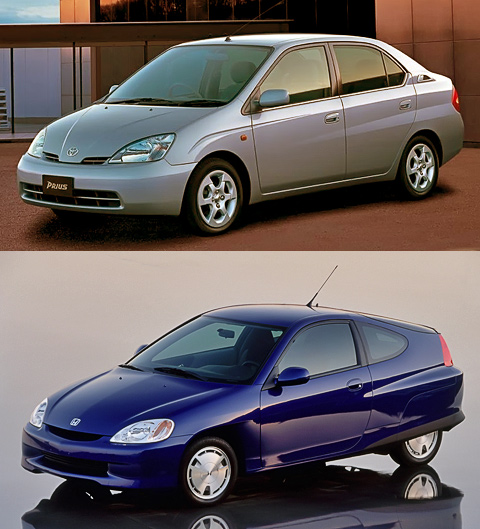
В 1997 году на японском рынке дебютировал первый гибрид — Toyota Prius (вверху). А в
1999-м
фирма Honda представила американцам свой Insight.
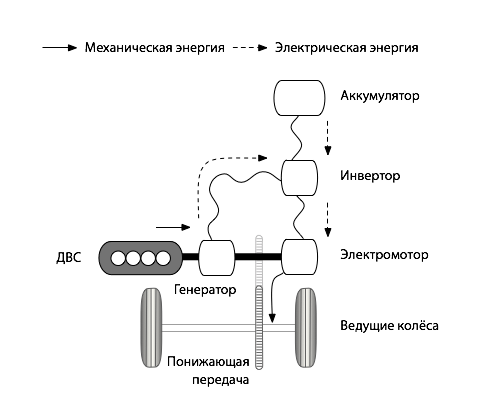
Последовательная гибридная схема
Существует также три основные схемы устройства гибридных силовых установок: последовательная, параллельная и смешанная. Последовательная гибридная схема появилась первой (её придумал в 1899 году сам Фердинанд Порше), но в легковых автомобилях распространена меньше. По ней, например, построены силовые агрегаты карьерных самосвалов, некоторых автобусов и локомотивов. В последовательной схеме колёса приводит в движение электромотор, а малолитражный ДВС крутит генератор, вырабатывающий электроэнергию. Тут отсутствует необходимость в коробке передач и мощном двигателе внутреннего сгорания. Зато требуются аккумуляторы, как правило, никель-металлогидридные, большой ёмкости.
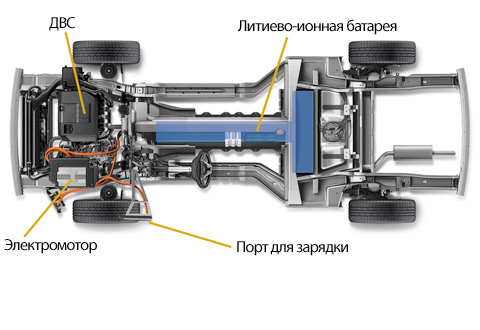
Chevrolet Volt построен по последовательной схеме. Его ещё называют электромобилем с увеличенным запасом хода. На электротяге автомобиль делает бросок длиной 64 км. А при использовании вспомогательного турбомотора, заряжающего батареи, пробег на одной заправке может превышать 1024 км.
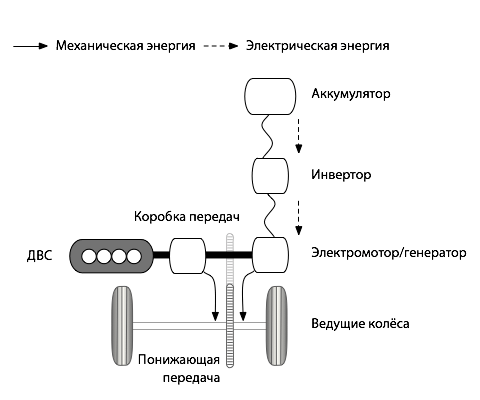
Параллельная гибридная схема
Самая распространённая сейчас схема — параллельная. Она запатентована ещё в 1905 году немцем Генри Пипером. Ей отвечают почти все умеренные гибриды. Они оснащаются мощным электромотором (10–15 кВт), который помогает двигателю внутреннего сгорания при разгоне, а при торможении запасает рекуперативную энергию. В качестве трансмиссии, как правило, используются вариатор или планетарная передача.

Хондовская гибиридная силовая установка IMA (Integrated Motor Assist) — пример параллельной схемы: на коленчатом валу двигателя вместо маховика размещён компактный электромотор-генератор.
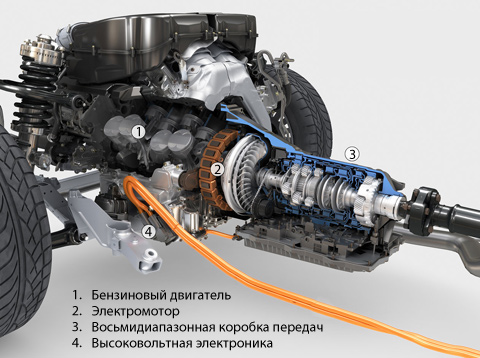
Один из последних образцов параллельной схемы — гибридная силовая установка седана BMW ActiveHybrid 7.
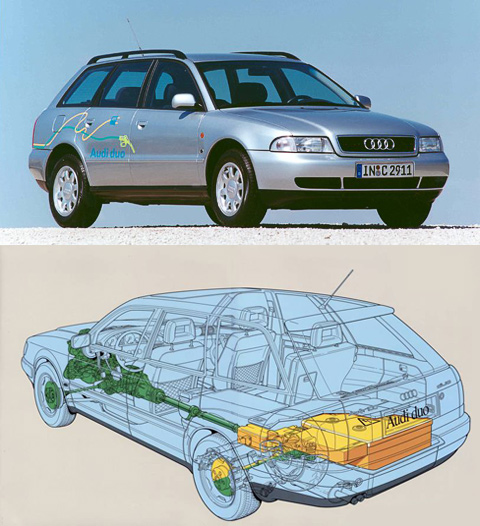
Параллельные гибриды могут быть не только умеренными, но и полными, как, например, Audi Duo (1998). Эта модель могла проехать 50 км только на электромоторе, приводящем в движение задние колёса.
Но компания Honda нашла возможным оснастить своё бензоэлектрическое купе CR-Z шестиступенчатой «механикой». В качестве источника питания используются литиево-ионные или литиево-полимерные аккумуляторы. Умеренные гибриды не требуют ёмких батарей на борту, благодаря чему доступны по цене. Однако некоторые автопроизводители присматриваются к дорогущим суперконденсаторам, которые способны кратковременно отдавать ток очень высокой мощности.
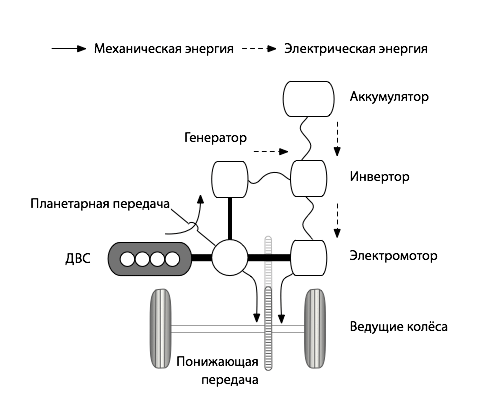
Последовательно-параллельная гибридная схема
Распространены также смешанные, или, как их ещё называют, последовательно-параллельные гибриды. Классические представители этого семейства — хэтчбек Toyota Prius и Лексусы с индексом h, оснащённые фирменным «синергитическим» приводом HSD (Hybrid Synergy Drive). Чтобы объяснить принцип его работы мы приводим ниже наглядную демонстрацию.
Благодаря планетарной передаче и возникает синергия — взаимодействие двигателя внутреннего сгорания и электромотора. Тут ДВС крутит колёса в паре с электромотором, одновременно вращая генератор. В традиционной коробке передач нет необходимости: электроника регулирует обороты моторов и генератора, превращая такую систему в бесступенчатую трансмиссию ECVT.
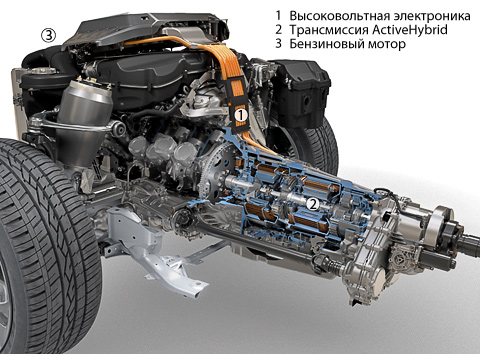
У BMW Active Hybrid X6 с бесступенчатой коробкой передач ECVT с несколькими планетарными рядами два электромотора. Один работает на малых скоростях. А другой запускает ДВС и затем служит генератором. Полноприводная трансмиссия xDrive сохранена.
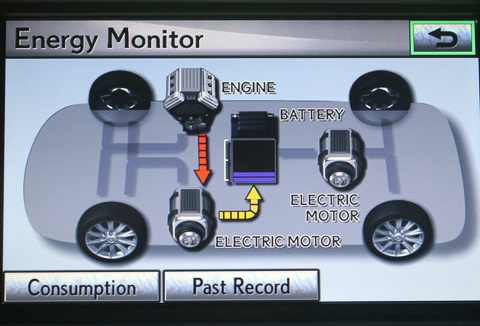
А вот у гибридного кроссовера Lexus RX 450h за привод на задние колёса отвечает дополнительный электромотор.
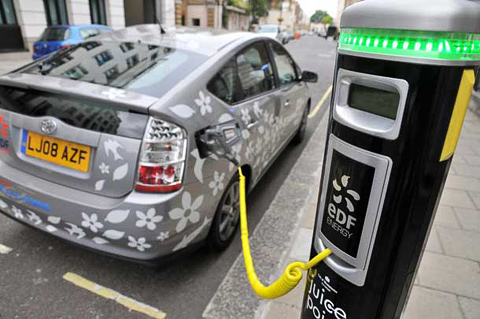
Новое поколение Тойоты Prius научилось бегать на одной электротяге, правда, недалеко — всего два километра. Кроме того, в компании работают над подзаряжаемой plug in версией гибрида с литиево-ионными батареями вместо никель-металлогидридных и увеличенным до 20 км пробегом на батареях.
Большинство двигателей, установленных на гибридах, — бензиновые. Многие работают по циклу Аткинсона с более коротким тактом сжатия и более эффективным рабочим процессом. Это обеспечивает лучшие экологические и экономические показатели. Распространение, казалось бы, более экономичных дизельэлектрических силовых установок сдерживает прежде всего то, что большинство гибридов продаются в не знакомой с дизелем Америке. Кроме того, дизельный мотор дороже бензинового, а это лишь увеличивает немалую цену гибрида.
A hybrid vehicle is one that uses two or more distinct types of power, such as submarines that use diesel when surfaced and batteries when submerged. Other means to store energy include pressurized fluid in hydraulic hybrids.
Hybrid powertrains are designed to switch from one power source to another to maximize both fuel efficiency and energy efficiency. In hybrid electric vehicles, for instance, the electric motor is more efficient at producing torque, or turning power, while the combustion engine is better for maintaining high speed. Improved efficiency, lower emissions, and reduced running costs relative to non-hybrid vehicles are three primary benefits of hybridization.
Vehicle types[edit]
Two-wheeled and cycle-type vehicles[edit]
Mopeds, electric bicycles, and even electric kick scooters are a simple form of a hybrid, powered by an internal combustion engine or electric motor and the rider’s muscles. Early prototype motorcycles in the late 19th century used the same principle.
- In a parallel hybrid bicycle human and motor torques are mechanically coupled at the pedal or one of the wheels, e.g. using a hub motor, a roller pressing onto a tire, or a connection to a wheel using a transmission element. Most motorized bicycles, mopeds are of this type.[1]
- In a series hybrid bicycle (SHB) (a kind of chainless bicycle) the user pedals a generator, charging a battery or feeding the motor, which delivers all of the torque required. They are commercially available, being simple in theory and manufacturing.[2]
The first published prototype of an SHB is by Augustus Kinzel (US Patent 3’884’317) in 1975. In 1994 Bernie Macdonalds conceived the Electrilite[3] SHB with power electronics allowing regenerative braking and pedaling while stationary. In 1995 Thomas Muller designed and built a «Fahrrad mit elektromagnetischem Antrieb» for his 1995 diploma thesis. In 1996 Jürg Blatter and Andreas Fuchs of Berne University of Applied Sciences built an SHB and in 1998 modified a Leitra tricycle (European patent EP 1165188). Until 2005 they built several prototype SH tricycles and quadricycles.[4] In 1999 Harald Kutzke described an «active bicycle»: the aim is to approach the ideal bicycle weighing nothing and having no drag by electronic compensation.
- A series hybrid electric-petroleum bicycle (SHEPB) is powered by pedals, batteries, a petrol generator, or plug-in charger—providing flexibility and range enhancements over electric-only bicycles.
A SHEPB prototype made by David Kitson in Australia[5] in 2014 used a lightweight brushless DC electric motor from an aerial drone and small hand-tool sized internal combustion engine, and a 3D printed drive system and lightweight housing, altogether weighing less than 4.5 kg. Active cooling keeps plastic parts from softening. The prototype uses a regular electric bicycle charge port.
Heavy vehicle[edit]
Hybrid power trains use diesel-electric or turbo-electric to power railway locomotives, buses, heavy goods vehicles, mobile hydraulic machinery, and ships. A diesel/turbine engine drives an electric generator or hydraulic pump, which powers electric/hydraulic motors—strictly an electric/hydraulic transmission (not a hybrid), unless it can accept power from outside. With large vehicles, conversion losses decrease and the advantages in distributing power through wires or pipes rather than mechanical elements become more prominent, especially when powering multiple drives—e.g. driven wheels or propellers. Until recently most heavy vehicles had little secondary energy storage, e.g. batteries/hydraulic accumulators—excepting non-nuclear submarines, one of the oldest production hybrids, running on diesel while surfaced and batteries when submerged. Both series and parallel setups were used in World War II-era submarines.
Rail transport[edit]
Europe
The new Autorail à grande capacité (AGC or high-capacity railcar) built by the Canadian company Bombardier for service in France is diesel/electric motors, using 1500 or 25000 V on different rail systems.[7] It was tested in Rotterdam, the Netherlands with Railfeeding, a Genesee & Wyoming company.
China
The First Hybrid Evaluating locomotive was designed by rail research center Matrai in 1999 and built in 2000. It was an EMD G12 locomotive upgraded with batteries, a 200 kW diesel generator, and four AC motors.
Japan
Japan’s first hybrid train with significant energy storage is the KiHa E200, with roof-mounted lithium ion batteries.[8]
India
Indian railway launched one of its kind CNG-Diesel hybrid trains in January 2015. The train has a 1400 hp engine which uses fumigation technology. The first of these trains is set to run on the 81 km long Rewari-Rohtak route.[9] CNG is less-polluting alternative for diesel and petrol and is popular as an alternative fuel in India. Already many transport vehicles such as auto-rickshaws and buses run on CNG fuel.
North America
In the US, General Electric made a locomotive with sodium–nickel chloride (Na-NiCl2) battery storage. They expect ≥10% fuel economy.[10][failed verification]
Variant diesel electric locomotive include the Green Goat (GG) and Green Kid (GK) switching/yard engines built by Canada’s Railpower Technologies, with lead acid (Pba) batteries and 1000 to 2000 hp electric motors, and a new clean-burning ≈160 hp diesel generator. No fuel is wasted for idling: ≈60–85% of the time for these types of locomotives. It is unclear if regenerative braking is used; but in principle, it is easily utilized.
Since these engines typically need extra weight for traction purposes anyway the battery pack’s weight is a negligible penalty.[citation needed] The diesel generator and batteries are normally built on an existing «retired» «yard» locomotive’s frame. The existing motors and running gear are all rebuilt and reused. Fuel savings of 40–60% and up to 80% pollution reductions are claimed over a «typical» older switching/yard engine. The advantages hybrid cars have for frequent starts and stops and idle periods apply to typical switching yard use.[11] «Green Goat» locomotives have been purchased by Canadian Pacific, BNSF, Kansas City Southern Railway and Union Pacific among others.
Cranes[edit]
Railpower Technologies engineers working with TSI Terminal Systems are testing a hybrid diesel-electric power unit with battery storage for use in Rubber Tyred Gantry (RTG) cranes. RTG cranes are typically used for loading and unloading shipping containers onto trains or trucks in ports and container storage yards. The energy used to lift the containers can be partially regained when they are lowered. Diesel fuel and emission reductions of 50–70% are predicted by Railpower engineers.[12] First systems are expected to be operational in 2007.[13]
Road transport, commercial vehicles[edit]
Hybrid systems are regularly in use for trucks, buses and other heavy highway vehicles. Small fleet sizes and installation costs are compensated by fuel savings,[14][needs update] with advances such as higher capacity, lowered battery cost, etc. Toyota, Ford, GM and others are introducing hybrid pickups and SUVs. Kenworth Truck Company recently introduced the Kenworth T270 Class 6 that for city usage seems to be competitive.[15][16] FedEx and others are investing in hybrid delivery vehicles—particularly for city use where hybrid technology may pay off first.[17] As of December 2013 FedEx is trialling two delivery trucks with Wrightspeed electric motors and diesel generators; the retrofit kits are claimed to pay for themselves in a few years. The diesel engines run at a constant RPM for peak efficiency.[18]
In 1978 students at Minneapolis, Minnesota’s Hennepin Vocational Technical Center, converted a Volkswagen Beetle to a petro-hydraulic hybrid with off-the shelf components. A car rated at 32 mpg was returning 75 mpg with the 60 hp engine replaced by a 16 hp engine, and reached 70 mph.[19]
In the 1990s, engineers at EPA’s National Vehicle and Fuel Emissions Laboratory developed a petro-hydraulic powertrain for a typical American sedan car. The test car achieved over 80 mpg on combined EPA city/highway driving cycles. Acceleration was 0-60 mph in 8 seconds, using a 1.9 liter diesel engine. No lightweight materials were used. The EPA estimated that produced in high volumes the hydraulic components would add only $700 to the cost.[20] Under EPA testing, a hydraulic hybrid Ford Expedition returned 32 mpg (7.4 L/100 km) City, and 22 mpg (11 L/100 km) highway.[20][21] UPS currently has two trucks in service using this technology.[22]
Military off-road vehicles[edit]
Since 1985, the US military has been testing serial hybrid Humvees[23][24] and have found them to deliver faster acceleration, a stealth mode with low thermal signature, near silent operation, and greater fuel economy.
Ships[edit]
Ships with both mast-mounted sails and steam engines were an early form of a hybrid vehicle. Another example is the diesel-electric submarine. This runs on batteries when submerged and the batteries can be recharged by the diesel engine when the craft is on the surface.
As of 2022, there are 550 ships with an average of 1.6 MWh of batteries. The average was 500 kWh in 2016.[25]
Newer hybrid ship-propulsion schemes include large towing kites manufactured by companies such as SkySails. Towing kites can fly at heights several times higher than the tallest ship masts, capturing stronger and steadier winds.
Aircraft[edit]
The Boeing Fuel Cell Demonstrator Airplane has a Proton Exchange Membrane (PEM) fuel cell/lithium-ion battery hybrid system to power an electric motor, which is coupled to a conventional propeller. The fuel cell provides all power for the cruise phase of flight. During takeoff and climb, the flight segment that requires the most power, the system draws on lightweight lithium-ion batteries.
The demonstrator aircraft is a Dimona motor glider, built by Diamond Aircraft Industries of Austria, which also carried out structural modifications to the aircraft. With a wingspan of 16.3 meters (53 feet), the airplane will be able to cruise at about 100 km/h (62 mph) on power from the fuel cell.[26]
Hybrid FanWings have been designed. A FanWing is created by two engines with the capability to autorotate and landing like a helicopter.[27]
Engine type[edit]
Hybrid electric-petroleum vehicles[edit]
When the term hybrid vehicle is used, it most often refers to a Hybrid electric vehicle. These encompass such vehicles as the Saturn Vue, Toyota Prius, Toyota Yaris, Toyota Camry Hybrid, Ford Escape Hybrid, Ford Fusion Hybrid, Toyota Highlander Hybrid, Honda Insight, Honda Civic Hybrid, Lexus RX 400h, and 450h, Hyundai Ioniq, and others. A petroleum-electric hybrid most commonly uses internal combustion engines (using a variety of fuels, generally gasoline or Diesel engines) and electric motors to power the vehicle. The energy is stored in the fuel of the internal combustion engine and an electric battery set. There are many types of petroleum-electric hybrid drivetrains, from Full hybrid to Mild hybrid, which offer varying advantages and disadvantages.[28]
William H. Patton filed a patent application for a gasoline-electric hybrid rail-car propulsion system in early 1889, and for a similar hybrid boat propulsion system in mid 1889.[29][30] There is no evidence that his hybrid boat met with any success, but he built a prototype hybrid tram and sold a small hybrid locomotive.[31][32]
In 1899, Henri Pieper developed the world’s first petro-electric hybrid automobile. In 1900, Ferdinand Porsche developed a series-hybrid using two motor-in-wheel-hub arrangements with an internal combustion generator set providing the electric power; Porsche’s hybrid set two-speed records.[citation needed]
While liquid fuel/electric hybrids date back to the late 19th century, the braking regenerative hybrid was invented by David Arthurs, an electrical engineer from Springdale, Arkansas, in 1978–79. His home-converted Opel GT was reported to return as much as 75 mpg with plans still sold to this original design, and the «Mother Earth News» modified version on their website.[33]
The plug-in-electric-vehicle (PEV) is becoming more and more common. It has the range needed in locations where there are wide gaps with no services. The batteries can be plugged into house (mains) electricity for charging, as well being charged while the engine is running.
Continuously outboard recharged electric vehicle[edit]
Some battery electric vehicles can be recharged while the user drives. Such a vehicle establishes contact with an electrified rail, plate, or overhead wires on the highway via an attached conducting wheel or other similar mechanisms (see conduit current collection). The vehicle’s batteries are recharged by this process—on the highway—and can then be used normally on other roads until the battery is discharged. For example, some of the battery-electric locomotives used for maintenance trains on the London Underground are capable of this mode of operation.
Developing an infrastructure for battery electric vehicles would provide the advantage of virtually unrestricted highway range. Since many destinations are within 100 km of a major highway, this technology could reduce the need for expensive battery systems. However, private use of the existing electrical system is almost universally prohibited. Besides, the technology for such electrical infrastructure is largely outdated and, outside some cities, not widely distributed (see Conduit current collection, trams, electric rail, trolleys, third rail). Updating the required electrical and infrastructure costs could perhaps be funded by toll revenue or by dedicated transportation taxes.
Hybrid fuel (dual mode)[edit]
In addition to vehicles that use two or more different devices for propulsion, some also consider vehicles that use distinct energy sources or input types («fuels») using the same engine to be hybrids, although to avoid confusion with hybrids as described above and to use correctly the terms, these are perhaps more correctly described as dual mode vehicles:
- Some trolleybuses can switch between an onboard diesel engine and overhead electrical power depending on conditions (see dual-mode bus). In principle, this could be combined with a battery subsystem to create a true plug-in hybrid trolleybus, although as of 2006, no such design seems to have been announced.
- Flexible-fuel vehicles can use a mixture of input fuels mixed in one tank—typically gasoline and ethanol, methanol, or biobutanol.
- Bi-fuel vehicle: Liquified petroleum gas and natural gas are very different from petroleum or diesel and cannot be used in the same tanks, so it would be challenging to build an (LPG or NG) flexible fuel system. Instead vehicles are built with two, parallel, fuel systems feeding one engine. For example, some Chevrolet Silverado 2500 HDs can effortlessly switch between petroleum and natural gas, offering a range of over 1000 km (650 miles).[34] While the duplicated tanks cost space in some applications, the increased range, decreased cost of fuel, and flexibility where LPG or CNG infrastructure is incomplete may be a significant incentive to purchase. While the US Natural gas infrastructure is partially incomplete, it is increasing and in 2013 had 2600 CNG stations in place.[35] Rising gas prices may push consumers to purchase these vehicles. In 2013 when gas prices traded around US$1.1 per litre ($4.0/US gal), the price of gasoline was US$95.5 per megawatt-hour ($28.00 per million British thermal units), compared to natural gas’s $13.6/MWh ($4.00 per million British thermal units).[36] On a per unit of energy comparative basis, this makes natural gas much cheaper than gasoline.
- Some vehicles have been modified to use another fuel source if it is available, such as cars modified to run on autogas (LPG) and diesels modified to run on waste vegetable oil that has not been processed into biodiesel.
- Power-assist mechanisms for bicycles and other human-powered vehicles are also included (see Motorized bicycle).
Fluid power hybrid[edit]
Hydraulic hybrid and pneumatic hybrid vehicles use an engine or regenerative braking (or both) to charge a pressure accumulator to drive the wheels via hydraulic (liquid) or pneumatic (compressed gas) drive units. In most cases the engine is detached from the drivetrain, serving solely to charge the energy accumulator. The transmission is seamless. Regenerative braking can be used to recover some of the supplied drive energy back into the accumulator.
Petro-air hybrid[edit]
A French company, MDI, has designed and has running models of a petro-air hybrid engine car. The system does not use air motors to drive the vehicle, being directly driven by a hybrid engine. The engine uses a mixture of compressed air and gasoline injected into the cylinders.[37] A key aspect of the hybrid engine is the «active chamber», which is a compartment heating air via fuel doubling the energy output.[38] Tata Motors of India assessed the design phase towards full production for the Indian market and moved into «completing detailed development of the compressed air engine into specific vehicle and stationary applications».[39][40]
Petro-hydraulic hybrid[edit]
Peugeot 2008 HYbrid air/hydraulic concept car
Peugeot 2008 HYbrid air/hydraulic cutaway
Petro-hydraulic configurations have been common in trains and heavy vehicles for decades. The auto industry recently focused on this hybrid configuration as it now shows promise for introduction into smaller vehicles.
In petro-hydraulic hybrids, the energy recovery rate is high and therefore the system is more efficient than electric battery charged hybrids using the current electric battery technology, demonstrating a 60% to 70% increase in energy economy in US Environmental Protection Agency (EPA) testing.[41] The charging engine needs only to be sized for average usage with acceleration bursts using the stored energy in the hydraulic accumulator, which is charged when in low energy demanding vehicle operation. The charging engine runs at optimum speed and load for efficiency and longevity. Under tests undertaken by the US Environmental Protection Agency (EPA), a hydraulic hybrid Ford Expedition returned 32 miles per US gallon (7.4 L/100 km; 38 mpg‑imp) City, and 22 miles per US gallon (11 L/100 km; 26 mpg‑imp) highway.[20][21] UPS currently has two trucks in service using this technology.[22]
Although petro-hydraulic hybrid technology has been known for decades and used in trains as well as very large construction vehicles, the high costs of the equipment precluded the systems from lighter trucks and cars. In the modern sense, an experiment proved the viability of small petro-hydraulic hybrid road vehicles in 1978. A group of students at Minneapolis, Minnesota’s Hennepin Vocational Technical Center, converted a Volkswagen Beetle car to run as a petro-hydraulic hybrid using off-the-shelf components. A car rated at 32 mpg‑US (7.4 L/100 km; 38 mpg‑imp) was returning 75 mpg‑US (3.1 L/100 km; 90 mpg‑imp) with the 60 hp engine replaced by a 16 hp engine. The experimental car reached 70 mph (110 km/h).[19]
In the 1990s, a team of engineers working at EPA’s National Vehicle and Fuel Emissions Laboratory succeeded in developing a revolutionary type of petro-hydraulic hybrid powertrain that would propel a typical American sedan car. The test car achieved over 80 mpg on combined EPA city/highway driving cycles. Acceleration was 0-60 mph in 8 seconds, using a 1.9 L diesel engine. No lightweight materials were used. The EPA estimated that produced in high volumes the hydraulic components would add only $700 to the base cost of the vehicle.[20]
The petro-hydraulic hybrid system has a faster and more efficient charge/discharge cycling than petro-electric hybrids and is also cheaper to build. The accumulator vessel size dictates total energy storage capacity and may require more space than an electric battery set. Any vehicle space consumed by a larger size of accumulator vessel may be offset by the need for a smaller sized charging engine, in HP and physical size.
Research is underway in large corporations and small companies. The focus has now switched to smaller vehicles. The system components were expensive which precluded installation in smaller trucks and cars. A drawback was that the power driving motors were not efficient enough at part load. A British company (Artemis Intelligent Power) made a breakthrough introducing an electronically controlled hydraulic motor/pump, the Digital Displacement® motor/pump. The pump is highly efficient at all speed ranges and loads, giving feasibility to small applications of petro-hydraulic hybrids.[42] The company converted a BMW car as a test bed to prove viability. The BMW 530i gave double the mpg in city driving compared to the standard car. This test was using the standard 3,000 cc engine, with a smaller engine the figures would have been more impressive. The design of petro-hydraulic hybrids using well sized accumulators allows downsizing an engine to average power usage, not peak power usage. Peak power is provided by the energy stored in the accumulator. A smaller more efficient constant speed engine reduces weight and liberates space for a larger accumulator.[43]
Current vehicle bodies are designed around the mechanicals of existing engine/transmission setups. It is restrictive and far from ideal to install petro-hydraulic mechanicals into existing bodies not designed for hydraulic setups. One research project’s goal is to create a blank paper design new car, to maximize the packaging of petro-hydraulic hybrid components in the vehicle. All bulky hydraulic components are integrated into the chassis of the car. One design has claimed to return 130 mpg in tests by using a large hydraulic accumulator which is also the structural chassis of the car. The small hydraulic driving motors are incorporated within the wheel hubs driving the wheels and reversing to claw-back kinetic braking energy. The hub motors eliminate the need for friction brakes, mechanical transmissions, driveshafts, and U-joints, reducing costs and weight. Hydrostatic drive with no friction brakes is used in industrial vehicles.[44] The aim is 170 mpg in average driving conditions. The energy created by shock absorbers and kinetic braking energy that normally would be wasted assists in charging the accumulator. A small fossil-fuelled piston engine sized for average power use charges the accumulator. The accumulator is sized at running the car for 15 minutes when fully charged. The aim is a fully charged accumulator that will produce a 0-60 mph acceleration speed of under 5 seconds using four wheel drive.[45][46][47]
In January 2011 industry giant Chrysler announced a partnership with the US Environmental Protection Agency (EPA) to design and develop an experimental petro-hydraulic hybrid powertrain suitable for use in large passenger cars. In 2012 an existing production minivan was adapted to the new hydraulic powertrain for assessment.[20][48][49][50]
PSA Peugeot Citroën exhibited an experimental «Hybrid Air» engine at the 2013 Geneva Motor Show.[51][52] The vehicle uses nitrogen gas compressed by energy harvested from braking or deceleration to power a hydraulic drive which supplements power from its conventional gasoline engine. The hydraulic and electronic components were supplied by Robert Bosch GmbH. Mileage was estimated to be about 118 mpg‑US (2 L/100 km; 142 mpg‑imp) on the Euro test cycle if installed in a Citroën C3 type of body.[53][54] PSA Although the car was ready for production and was proven and feasible delivering the claimed results, Peugeot Citroën were unable to attract a major manufacturer to share the high development costs and are shelving the project until a partnership can be arranged.[55]
Electric-human power hybrid vehicle[edit]
Another form of a hybrid vehicle are the human-powered electric vehicles. These include such vehicles as the Sinclair C5, Twike, electric bicycles, electric skateboards, and Electric motorcycles and scooters
Hybrid vehicle power train configurations[edit]
Parallel hybrid[edit]
In a parallel hybrid vehicle, an electric motor and an internal combustion engine are coupled such that they can power the vehicle either individually or together. Most commonly the internal combustion engine, the electric motor and gearbox are coupled by automatically controlled clutches. For electric driving, the clutch between the internal combustion engine is open while the clutch to the gearbox is engaged. While in combustion mode the engine and motor run at the same speed.
The first mass-production parallel hybrid sold outside Japan was the 1st generation Honda Insight.
The Mercedes-Benz E 300 BlueTEC HYBRID released in 2012 only in European markets is a very rare mass-produced diesel hybrid vehicle powered by a Mercedes-Benz OM651 engine developing 152 kW (204 hp) paired with a 20 kW (27 hp) electric motor, positioned between the engine and the gearbox, for a combined output of 170 kW (228 hp). The vehicle has a fuel consumption rate of 24–26 km/L (56–62 mpg‑US; 67–74 mpg‑imp).[56][57][58]
Mild parallel hybrid[edit]
These types use a generally compact electric motor (usually <20 kW) to provide auto-stop/start features and to provide extra power assist[59] during the acceleration, and to generate on the deceleration phase (also known as regenerative braking).
On-road examples include Honda Civic Hybrid, Honda Insight 2nd generation, Honda CR-Z, Honda Accord Hybrid, Mercedes Benz S400 BlueHYBRID, BMW 7 Series hybrids, General Motors BAS Hybrids, Suzuki S-Cross, Suzuki Wagon R and Smart fortwo with micro hybrid drive.
Power-split or series-parallel hybrid[edit]
In a power-split hybrid electric drive train, there are two motors: a traction electric motor and an internal combustion engine. The power from these two motors can be shared to drive the wheels via a power split device, which is a simple planetary gear set. The ratio can be from 100% for the combustion engine to 100% for the traction electric motor, or anything in between. The combustion engine can act as a generator charging the batteries.
Modern versions such as the Toyota Hybrid Synergy Drive have a second electric motor/generator connected to the planetary gear. In cooperation with the traction motor/generator and the power-split device, this provides a continuously variable transmission.
On the open road, the primary power source is the internal combustion engine. When maximum power is required, for example, to overtake, the traction electric motor is used to assist. This increases the available power for a short period, giving the effect of having a larger engine than actually installed. In most applications, the combustion engine is switched off when the car is slow or stationary thereby reducing curbside emissions.
Passenger car installations include Toyota Prius, Ford Escape and Fusion, as well as Lexus RX400h, RX450h, GS450h, LS600h, and CT200h.
Series hybrid[edit]
A series- or serial-hybrid vehicle is driven by an electric motor, functioning as an electric vehicle while the battery pack energy supply is sufficient, with an engine tuned for running as a generator when the battery pack is insufficient. There is typically no mechanical connection between the engine and the wheels, and the primary purpose of the range extender is to charge the battery. Series-hybrids have also been referred to as extended range electric vehicle, range-extended electric vehicle, or electric vehicle-extended range (EREV/REEV/EVER).
The BMW i3 with Range Extender is a production series-hybrid. It operates as an electric vehicle until the battery charge is low, and then activates an engine-powered generator to maintain power, and is also available without the range extender. The Fisker Karma was the first series-hybrid production vehicle.
When describing cars, the battery of a series-hybrid is usually charged by being plugged in—but a series-hybrid may also allow for a battery to only act as a buffer (and for regeneration purposes), and for the electric motor’s power to be supplied constantly by a supporting engine. Series arrangements have been common in diesel-electric locomotives and ships. Ferdinand Porsche effectively invented this arrangement in speed-record-setting racing cars in the early 20th century, such as the Lohner–Porsche Mixte Hybrid. Porsche named his arrangement «System Mixt» and it was a wheel hub motor design, where each of the two front wheels was powered by a separate motor. This arrangement was sometimes referred to as an electric transmission, as the electric generator and driving motor replaced a mechanical transmission. The vehicle could not move unless the internal combustion engine was running.
In 1997 Toyota released the first series-hybrid bus sold in Japan.[60] GM introduced the Chevy Volt series plug-in hybrid in 2010, aiming for an all-electric range of 40 mi (64 km),[61] though this car also has a mechanical connection between the engine and drivetrain.[62] Supercapacitors combined with a lithium ion battery bank have been used by AFS Trinity in a converted Saturn Vue SUV vehicle. Using supercapacitors they claim up to 150 mpg in a series-hybrid arrangement.[63]
Nissan Note e-power is an example of a series hybrid technology since 2016 in Japan.
Plug-in hybrid electric vehicle[edit]
Another subtype of hybrid vehicles is the plug-in hybrid electric vehicle. The plug-in hybrid is usually a general fuel-electric (parallel or serial) hybrid with increased energy storage capacity, usually through a lithium-ion battery, which allows the vehicle to drive on all-electric mode a distance that depends on the battery size and its mechanical layout (series or parallel). It may be connected to mains electricity supply at the end of the journey to avoid charging using the on-board internal combustion engine.[64][65]
This concept is attractive to those seeking to minimize on-road emissions by avoiding—or at least minimizing—the use of ICE during daily driving. As with pure electric vehicles, the total emissions saving, for example in CO2 terms, is dependent upon the energy source of the electricity generating company.
For some users, this type of vehicle may also be financially attractive so long as the electrical energy being used is cheaper than the petrol/diesel that they would have otherwise used. Current tax systems in many European countries use mineral oil taxation as a major income source. This is generally not the case for electricity, which is taxed uniformly for the domestic customer, however that person uses it. Some electricity suppliers also offer price benefits for off-peak night users, which may further increase the attractiveness of the plug-in option for commuters and urban motorists.
Road safety for cyclists, pedestrians[edit]
A 2009 National Highway Traffic Safety Administration report examined hybrid electric vehicle accidents that involved pedestrians and cyclists and compared them to accidents involving internal combustion engine vehicles (ICEV). The findings showed that, in certain road situations, HEVs are more dangerous for those on foot or bicycle. For accidents where a vehicle was slowing or stopping, backing up, entering, or leaving a parking space (when the sound difference between HEVs and ICEVs is most pronounced), HEVs were twice as likely to be involved in a pedestrian crash than ICEVs. For crashes involving cyclists or pedestrians, there was a higher incident rate for HEVs than ICEVs when a vehicle was turning a corner. However, there was no statistically significant difference between the types of vehicles when they were driving straight.[66]
Several automakers developed electric vehicle warning sounds designed to alert pedestrians to the presence of electric drive vehicles such as hybrid electric vehicle, plug-in hybrid electric vehicles and all-electric vehicles (EVs) travelling at low speeds. Their purpose is to make pedestrians, cyclists, the blind, and others aware of the vehicle’s presence while operating in all-electric mode.[67][68][69][70]
Vehicles in the market with such safety devices include the Nissan Leaf, Chevrolet Volt, Fisker Karma, Honda FCX Clarity, Nissan Fuga Hybrid/Infiniti M35, Hyundai ix35 FCEV, Hyundai Sonata Hybrid, 2012 Honda Fit EV, the 2012 Toyota Camry Hybrid, 2012 Lexus CT200h, and all the Prius family of cars.
Environmental issues[edit]
Fuel consumption and emissions reductions[edit]
The hybrid vehicle typically achieves greater fuel economy and lower emissions than conventional internal combustion engine vehicles (ICEVs), resulting in fewer emissions being generated. These savings are primarily achieved by three elements of a typical hybrid design:
- Relying on both the engine and the electric motors for peak power needs, resulting in a smaller engine size more for average usage rather than peak power usage. A smaller engine can have fewer internal losses and lower weight.
- Having significant battery storage capacity to store and reuse recaptured energy, especially in stop-and-go traffic typical of the city driving cycle.
- Recapturing significant amounts of energy during braking that are normally wasted as heat. This regenerative braking reduces vehicle speed by converting some of its kinetic energy into electricity, depending upon the power rating of the motor/generator;
Other techniques that are not necessarily ‘hybrid’ features, but that are frequently found on hybrid vehicles include:
- Using Atkinson cycle engines instead of Otto cycle engines for improved fuel economy.
- Shutting down the engine during traffic stops or while coasting or during other idle periods.
- Improving aerodynamics; (part of the reason that SUVs get such bad fuel economy is the drag on the car. A box-shaped car or truck has to exert more force to move through the air causing more stress on the engine making it work harder). Improving the shape and aerodynamics of a car is a good way to help better the fuel economy and also improve vehicle handling at the same time.
- Using low rolling resistance tires (tires were often made to give a quiet, smooth ride, high grip, etc., but efficiency was a lower priority). Tires cause mechanical drag, once again making the engine work harder, consuming more fuel. Hybrid cars may use special tires that are more inflated than regular tires and stiffer or by choice of carcass structure and rubber compound have lower rolling resistance while retaining acceptable grip, and so improving fuel economy whatever the power source.
- Powering the a/c, power steering, and other auxiliary pumps electrically as and when needed; this reduces mechanical losses when compared with driving them continuously with traditional engine belts.
These features make a hybrid vehicle particularly efficient for city traffic where there are frequent stops, coasting, and idling periods. In addition noise emissions are reduced, particularly at idling and low operating speeds, in comparison to conventional engine vehicles. For continuous high-speed highway use, these features are much less useful in reducing emissions.
Hybrid vehicle emissions[edit]
Hybrid vehicle emissions today are getting close to or even lower than the recommended level set by the EPA (Environmental Protection Agency). The recommended levels they suggest for a typical passenger vehicle should be equated to 5.5 metric tons of CO2. The three most popular hybrid vehicles, Honda Civic, Honda Insight and Toyota Prius, set the standards even higher by producing 4.1, 3.5, and 3.5 tons showing a major improvement in carbon dioxide emissions. Hybrid vehicles can reduce air emissions of smog-forming pollutants by up to 90% and cut carbon dioxide emissions in half.[71]
An increase in fossil fuels is needed to build hybrid vehicles versus conventional cars. This increase is more than offset by reduced emissions when running the vehicle.[72]
Hybrid CO2 emissions have been understated when comparing certification cycles to real-world driving. In one study using real-world driving data, it was shown they use on average 120 g of CO2 per km instead of the 44 g per km in official tests.[73]
Toyota states that three Hybrid vehicles equal one battery electric vehicle in CO2 reduction effect from carbon neutrality viewpoint which means reducing CO2 emissions to zero throughout the entire life cycle of a product, starting from procurement of raw materials, manufacturing, and transportation to use, recycling, and disposal.[74]
Environmental impact of hybrid car battery[edit]
Though hybrid cars consume less fuel than conventional cars, there is still an issue regarding the environmental damage of the hybrid car battery.[75][76] Today, most hybrid car batteries are Lithium-ion, which has higher energy density than nickel–metal hydride batteries and is more environmentally friendly than lead-based batteries which constitute the bulk of petrol car starter batteries today.[77]
There are many types of batteries. Some are far more toxic than others. Lithium ion is the least toxic of the batteries mentioned above.[78]
The toxicity levels and environmental impact of nickel metal hydride batteries—the type previously used in hybrids—are much lower than batteries like lead acid or nickel cadmium according to one source.[79] Another source claims nickel metal hydride batteries are much more toxic than lead batteries, also that recycling them and disposing of them safely is difficult.[80] In general various soluble and insoluble nickel compounds, such as nickel chloride and nickel oxide, have known carcinogenic effects in chick embryos and rats.[81][82][83] The main nickel compound in NiMH batteries is nickel oxyhydroxide (NiOOH), which is used as the positive electrode. However Nickel Metal Hydride Batteries have fallen out of favour in hybrid vehicles as various Lithium Ion Chemistries have become more mature to market.
The lithium-ion battery has become a market leader in this segment due to its high energy density, stability, and cost when compared to other technologies.[84] A market leader in this area is Panasonic with their partnership with Tesla[85][86][87][88]
The lithium-ion batteries are appealing because they have the highest energy density of any rechargeable batteries and can produce a voltage more than three times that of nickel–metal hydride battery cell while simultaneously storing large quantities of electricity as well.[77] The batteries also produce higher output (boosting vehicle power), higher efficiency (avoiding wasteful use of electricity), and provides excellent durability, compared with the life of the battery being roughly equivalent to the life of the vehicle.[89] Additionally, the use of lithium-ion batteries reduces the overall weight of the vehicle and also achieves improved fuel economy of 30% better than petro-powered vehicles with a consequent reduction in CO2 emissions helping to prevent global warming.
[90]
Lithium-ion batteries are also safer to recycle, with Volkswagen Group pioneering processes to recycle lithium-ion batteries;[91] this is also being chased by various other large companies, such as BMW,[92] Audi,[93] Mercedes-Benz[94] and Tesla.[95] The main goal within many of these companies is to combat disinformation about the nature of lithium batteries, primarily that they are not recyclable, which primarily stem from articles discussing the difficulties of recycling.[96][97][98]
Charging[edit]
There are two different levels of charging in plug-in hybrids. Level one charging is the slower method as it uses a 120 V/15 A single-phase grounded outlet. Level two is a faster method; existing Level 2 equipment offers charging from 208 V or 240 V (at up to 80 A, 19.2 kW). It may require dedicated equipment and a connection installation for home or public units.[99] The optimum charging window for Lithium-ion batteries is 3–4.2 V. Recharging with a 120 volt household outlet takes several hours, a 240 volt charger takes 1–4 hours, and a quick charge takes approximately 30 minutes to achieve 80% charge. Three important factors—distance on charge, cost of charging, and time to charge [100]
In order for hybrids to run on electrical power, the car must perform the action of braking in order to generate some electricity. The electricity then gets discharged most effectively when the car accelerates or climbs up an incline.
In 2014, hybrid electric car batteries can run on solely electricity for 70–130 miles (110–210 km) on a single charge. Hybrid battery capacity currently ranges from 4.4 kWh to 85 kWh on a fully electric car. On a hybrid car, the battery packs currently range from 0.6 kWh to 2.4 kWh representing a large difference in use of electricity in hybrid cars.[101]
Raw materials increasing costs[edit]
|
|
This article needs to be updated. Please help update this article to reflect recent events or newly available information. (February 2014) |
There is an impending increase in the costs of many rare materials used in the manufacture of hybrid cars.[102] For example, the rare-earth element dysprosium is required to fabricate many of the advanced electric motors and battery systems in hybrid propulsion systems.[102][103] Neodymium is another rare earth metal which is a crucial ingredient in high-strength magnets that are found in permanent magnet electric motors.[104]
Nearly all the rare-earth elements in the world come from China,[105] and many analysts believe that an overall increase in Chinese electronics manufacturing will consume this entire supply by 2012.[102] In addition, export quotas on Chinese rare-earth elements have resulted in an unknown amount of supply.[103][106]
A few non-Chinese sources such as the advanced Hoidas Lake project in northern Canada as well as Mount Weld in Australia are currently under development;[106] however, the barriers to entry are high[107] and require years to go online.
How hybrid-electric vehicles work[edit]
Hybrids-Electric vehicles (HEVs) combine the advantage of gasoline engines and electric motors. The key areas for efficiency or performance gains are regenerative braking, dual power sources, and less idling.[108]
- Regenerative braking. The electric motor normally converts electricity into physical motion. Used in reverse as a generator, it can also convert physical motion into electricity. This both slows the car (braking) and recharges (regenerates) the batteries.
- Dual power. Power can come from either the engine, motor, or both depending on driving circumstances. Additional power to assist the engine in accelerating or climbing might be provided by the electric motor. Or more commonly, a smaller electric motor provides all of the power for low-speed driving conditions and is augmented by the engine at higher speeds.
- Automatic start/shutoff. It automatically shuts off the engine when the vehicle comes to a stop and restarts it when the accelerator is pressed down. This automation is much simpler with an electric motor. Also, see dual power above.
Alternative green vehicles[edit]
Other types of green vehicles include other vehicles that go fully or partly on alternative energy sources than fossil fuel. Another option is to use alternative fuel composition (i.e. biofuels) in conventional fossil fuel-based vehicles, making them go partly on renewable energy sources.
Other approaches include personal rapid transit, a public transportation concept that offers automated on-demand non-stop transportation, on a network of specially built guideways.
Marketing[edit]
Adoption[edit]
Automakers spend around $US8 million in marketing Hybrid vehicles each year. With combined effort from many car companies, the Hybrid industry has sold millions of Hybrids.[citation needed]
Hybrid car companies like Toyota, Honda, Ford, and BMW have pulled together to create a movement of Hybrid vehicle sales pushed by Washington lobbyists to lower the world’s emissions and become less reliant on our petroleum consumption.[citation needed]
In 2005, sales went beyond 200,000 Hybrids, but in retrospect that only reduced the global use for gasoline consumption by 200,000 gallons per day—a tiny fraction of the 360 million gallons used per day.[citation needed] According to Bradley Berman author of Driving Change—One Hybrid at a time, «cold economics shows that in real dollars, except for a brief spike in the 1970s, gas prices have remained remarkably steady and cheap. Fuel continues to represent a small part of the overall cost of owning and operating a personal vehicle».[109] Other marketing tactics include greenwashing which is the «unjustified appropriation of environmental virtue.»[110]
Temma Ehrenfeld explained in an article by Newsweek. Hybrids may be more efficient than many other gasoline motors as far as gasoline consumption is concerned but as far as being green and good for the environment is completely inaccurate.
Hybrid car companies have a long time to go if they expect to really go green. According to Harvard business professor Theodore Levitt states «managing products» and «meeting customers’ needs», «you must adapt to consumer expectations and anticipation of future desires.»[111] This means people buy what they want, if they want a fuel efficient car they buy a Hybrid without thinking about the actual efficiency of the product. This «green myopia» as Ottman calls it, fails because marketers focus on the greenness of the product and not on the actual effectiveness.
Researchers and analysts say people are drawn to the new technology, as well as the convenience of fewer fill-ups. Secondly, people find it rewarding to own the better, newer, flashier, and so-called greener car.
Misleading advertising[edit]
In 2019 the term self-charging hybrid became prevalent in advertising, though cars referred to by this name do not offer any different functionality than a standard hybrid electric vehicle provides. The only self-charging effect is in energy recovery via regenerative braking, which is also true of plug-in hybrids, fuel cell electric vehicles and battery electric vehicles.[112]
In January 2020, using this term has been prohibited in Norway, for misleading advertising by Toyota and Lexus.[113] «Our claim is based on the fact that customers never have to charge the battery of their vehicle, as it is recharged during the vehicle use. There is no intention to mislead customers, on the contrary: the point is to clearly explain the difference with plug-in hybrid vehicles.»
Adoption rate[edit]
While the adoption rate for hybrids in the US is small today (2.2% of new car sales in 2011),[114] this compares with a 17.1% share of new car sales in Japan in 2011,[115] and it has the potential to be very large over time as more models are offered and incremental costs decline due to learning and scale benefits. However, forecasts vary widely. For instance, Bob Lutz, a long-time skeptic of hybrids, indicated he expects hybrids «will never comprise more than 10% of the US auto market.»[116] Other sources also expect hybrid penetration rates in the US will remain under 10% for many years.[117][118][119]
More optimistic views as of 2006 include predictions that hybrids would dominate new car sales in the US and elsewhere over the next 10 to 20 years.[120] Another approach, taken by Saurin Shah, examines the penetration rates (or S-curves) of four analogs (historical and current) to hybrid and electrical vehicles in an attempt to gauge how quickly the vehicle stock could be hybridized and/or electrified in the United States. The analogs are (1) the electric motors in US factories in the early 20th century, (2) diesel-electric locomotives on US railways in the 1920–1945 period, (3) a range of new automotive features/technologies introduced in the US over the past fifty years, and 4) e-bike purchases in China over the past few years. These analogs collectively suggest it would take at least 30 years for hybrid and electric vehicles to capture 80% of the US passenger vehicle stock.[121]
The EPA expects the combined market share of new gasoline hybrid light-duty vehicles to reach 10.1% for the 2022 model year from 9.3% in the 2021 model year.[122]
European Union 2020 regulation standards[edit]
The European Parliament, Council, and European Commission have reached an agreement which is aimed at reducing the average CO2 passenger car emissions to 95 g/km by 2020, according to a European Commission press release.
According to the release, the key details of the agreement are as follows:
Emissions target: The agreement will reduce average CO2 emissions from new cars to 95 g/km from 2020, as proposed by the commission. This is a 40% reduction from the mandatory 2015 target of 130 g/km. The target is an average for each manufacturer’s new car fleet; it allows OEMs to build some vehicles that emit less than the average and some that emit more.
2025 target: The commission is required to propose a further emissions reduction target by the end-2015 to take effect in 2025. This target will be in line with the EU’s long-term climate goals.
Super credits for low-emission vehicles: The Regulation will give manufacturers additional incentives to produce cars with CO2 emissions of 50 g/km or less (which will be electric or plug-in hybrid cars). Each of these vehicles will be counted as two vehicles in 2020, 1.67 in 2021, 1.33 in 2022, and then as one vehicle from 2023 onwards. These super credits will help manufacturers further reduce the average emissions of their new car fleet. However, to prevent the scheme from undermining the environmental integrity of the legislation, there will be a 2.5 g/km cap per manufacturer on the contribution that super credits can make to their target in any year.[123]
See also[edit]
- Alternative propulsion
- Bivalent (engine)
- Efficient energy use
- Electric vehicle
- Global Hybrid Cooperation
- Global warming
- Human-electric hybrid vehicle
- Hybrid vehicle drivetrain
- List of hybrid vehicles
- Multifuel stove
- PNGV
- Solid oxide fuel cell
- Triple-hybrid
References[edit]
- ^ Neupert, Hannes (1997). Das Power bike (in German). Moby-Dick-Verlag. ISBN 978-3-89595-123-7. Retrieved 2007-02-27.
- ^ Fuchs, Andreas (1999). Velomobile Seminar. ISBN 978-3-9520694-1-7. Retrieved 2006-01-11.
- ^ «Greetings Ecological Transportation Futurist». MCN.org. Archived from the original on 2005-11-10. Retrieved 2013-04-30.
- ^ «Welcome to the electronic cycle site». bluewin.ch. 2015-05-06. Archived from the original on 2015-10-16. Retrieved 2013-04-22.
- ^ «Australian man builds the first ever hybrid petrol/electric bicycle using UP Mini 3D printer». Archived from the original on 2015-08-22.
- ^ «Van Hool presents the ExquiCity Design Mettis». Archived from the original on 2013-06-05. Retrieved 2012-06-05.
- ^ «The World’s First Hybrid Train Officially Enters Commercial Service». ENN.com. 2007-10-24. Retrieved 2012-01-13.
- ^ «Japan to launch first hybrid trains». Sydney Morning Herald. AP digital. 2007-07-29. Retrieved 2013-04-30.
- ^ «CNG-Diesel train launch in India». Times of India. 2015-01-15. Retrieved 2015-04-22.
- ^ Shabna, John (2007-10-25). «GE’s Hybrid Locomotive: Around The World on Brakes». Ecotality Life. Archived from the original on 2009-02-28.
- ^ RailPower Technologies (2006-07-12). «GG Series: Hybrid Yard Switcher» (PDF). Archived from the original (PDF) on 2009-03-20.
- ^ «RailPower To Supply TSI Terminal Systems Inc. with hybrid power plants for rubber tyred gantry cranes» (PDF) (Press release). 2006-10-10. Archived from the original (PDF) on 2008-02-28.
- ^ «Railpower to supply TSI Terminal Systems Inc. with hybrid power plants for rubber tyred gantry cranes» (Press release). RailPower Technologies Corp. 2006-10-10.
- ^ Brown, Matthew. But Daniel thinks «Energy debate heats up: the high gas prices of last summer fueled the energy debate that continues today.» State Legislatures 32.2 (February 2006): 12(5). Expanded Academic ASAP. Gale. Bentley Upper School Library (BAISL). 14 October 2009 Galegroup.co
- ^ Thomas, Justin (2007-03-27). «Hybrid Truck Unveiled by Kenworth». TreeHugger.
- ^ «Kenworth Unveils T270 Class 6 Hybrid Truck Targeted at Municipal, Utility Applications» (Press release). Kenworth Truck Company. 2007-03-21. Archived from the original on 2009-03-01.
- ^ Hetzner, Christian (2007-11-12), Hard sell for hybrid trucks, Reuters, archived from the original on 2014-09-03
- ^ Golson, Jordan (2014-09-30). «FedEx’s New Electric Trucks Get a Boost From Diesel Turbines». Wired. Retrieved 2014-10-01.
- ^ a b «Try a Hydraulic Drive Train: This Car of the Future Gets 75 MPG». Mother Earth News. March–April 1978. Archived from the original on 2012-10-25. Retrieved 2013-04-22.
- ^ a b c d e «Demonstration Vehicles». Epa.gov. 2012-10-18. Retrieved 2013-04-22.
- ^ a b Capturing the power of hydraulics. AutoblogGreen. Retrieved on 2012-04-18.
- ^ a b EPA unveils hydraulic hybrid UPS delivery truck. Autoblog. Retrieved on 2012-04-18.
- ^ Komarow, Steven (2006-02-13). «Military hybrid vehicles could boost safety, mobility». USA Today.
- ^ Day, Lewin (20 July 2022). «The US Army Bought a GMC Hummer EV for Testing». The Drive. Retrieved 1 October 2023.
- ^ Wingrove, Martyn (24 February 2022). «Huge increase in European hybrid and electric vessels expected». Riviera.
- ^ «Manned airplane powered by fuel cell makes flight tests. (metals/polymers/ceramics).» Advanced Materials & Processes. 165.6 (June 2007): 9(1). Expanded Academic ASAP. Gale. Gale Document Number:A166034681
- ^ Namowitz, Dan (2011-12-20). «AOPA ONLINE». Thomas A. Horne. Retrieved 2018-05-10.
- ^ «Fuel Saving Calculator».
- ^ US 409116, Patton, W. H., «Motor for Street Cars», issued 1889-08-13
- ^ US 424817, Patton, W. H., «Boat», issued 1890-04-01
- ^ «The Patton Motor». The Street Railway Journal. VII (10): 513–514. October 1891.
- ^ «The Patton Motor Car». English Mechanic and World of Science (1713): 524. 1898-01-21.
- ^ Marshall, Robert W. (July 1979). «Electric Car Conversion: The Amazing 75-MPG Hybrid Car». Mother Earth News. US. Archived from the original on 2009-05-08. Retrieved 2012-04-18.
- ^ «Bi-Fuel Silverado 2500HD Can Switch Between Gasoline And Natural Gas». Retrieved 2013-03-31.
- ^ «Alternative Fueling Station Counts by State». Retrieved 2013-03-31.
- ^ Halber, Deborah. «What is the energy of gasoline compared to the same cost of other fuels in BTUs per dollar?». Archived from the original on 2013-04-06. Retrieved 2013-03-31.
- ^ «Learn everything about the compressed air cars!». Aircars.tk. Archived from the original on 2013-05-20. Retrieved 2013-04-30.
- ^ «MDI’s active chamber». Thefuture.net.nz. Archived from the original on 2011-05-07. Retrieved 2010-12-12.
- ^ «MDI’s air engine technology tested on Tata Motors vehicles» (Press release). Tata Motors. 2012-05-07. Archived from the original on 2013-05-09. Retrieved 2013-04-22.
- ^ «Tata Motors enters second phase of air-car development». Gizmag.com. 2013-05-07. Retrieved 2013-04-22.
- ^ EPA Announces Partnership to Demonstrate World’s First Full Hydraulic Hybrid Urban Delivery Vehicle | Modeling, Testing, and Research | US EPA. Epa.gov. Retrieved on 2012-04-18. Archived 2011-08-09 at the Wayback Machine
- ^ «Our Technology | Artemis Intelligent Power». Archived from the original on 2013-10-17. Retrieved 2013-10-17.
- ^ «On-road». Archived from the original on 2015-05-25. Retrieved 2015-05-30.
- ^ «Lift Trucks: 15 ways the lift truck is evolving — Article from Modern Materials Handling». Modern Materials Handling. 2011-08-01. Retrieved 2013-04-22.
- ^ Proefrock, Philip (2010-03-25). «Hybrid Hydraulic Drive Vehicle Promises 170 MPG». Inhabitat. Retrieved 2013-04-22.
- ^ Turpen, Aaron (2012-02-15). «INGOCAR from Valentin Tech shatters the way we think about cars». Torquenews.com. Retrieved 2013-04-22.
- ^ «Welcome». Valentintechnologies.com. Archived from the original on 2013-04-21. Retrieved 2013-04-22.
- ^ Hanlon, Mike (2011-01-26). «Chrysler announces development of hydraulic hybrid technology for cars». Gizmag.com. Retrieved 2013-04-22.
- ^ «EPA and Chrysler to Take Latest Hybrid Technology from Lab to Street/Partnership to adapt fuel efficient technology». Yosemite.epa.gov (Press release). 2011-01-19. Retrieved 2013-04-22.
- ^ «Hydraulic Hybrid Research». US EPA. 2010-10-18. Retrieved 2013-04-22.
- ^ Lewis, Tim (2013-03-23). «Peugeot’s Hybrid Air: the car of the future that runs on air». The Observer The Guardian. Retrieved 2013-03-25.
- ^ Marc Carter (25 January 2013). «Peugeot Announces Plans to Release a Hybrid Car That Runs on Compressed Air by 2016». Retrieved 2015-05-30.
- ^ «A Pair of Peugeots Debuts in Paris: One Prescient (and Possibly Good for 118 mpg), One Practical». 2014-10-02.
- ^ Jolly, David (2013-03-01). «Compressing Gas for a Cheaper, Simpler Hybrid». The New York Times. Retrieved 2013-03-02.
- ^ «PSA puts Hybrid Air technology on back burner». Autocar.
- ^ «Mercedes-Benz E 300 BlueTEC HYBRID: The world’s most fuel-efficient luxury-class model». marsMediaSite.
- ^ «Not-For-U.S. Mercedes-Benz E300 BlueTec Hybrid Headed to Detroit Auto Show». Car and Driver. December 22, 2011.
- ^ «Mercedes-Benz introducing diesel E 300 BlueTEC HYBRID with fuel economy of 56 mpg US; gasoline-engined E 400 HYBRID model to follow». Green Car Congress.
- ^ «Honda IMA technology». Honda Motor. Retrieved 2009-05-01.
- ^ «Toyota debuts power-hybrid bus | The Japan Times Online». Search.japantimes.co.jp. 1997-08-22. Retrieved 2009-10-17.
- ^ Stossel, Sage (2008-05-06). «Electro-Shock Therapy – The Atlantic (July/August 2008)». The Atlantic. Retrieved 2009-10-17.
- ^ «Shocker». 2010-10-11.
- ^ «afstrinity.com». Archived from the original on December 29, 2008.
- ^ California Cars Initiative. «All About Plug-In Hybrids (PHEVs)». International Humanities Center. Retrieved 2013-05-01.
- ^ «Prius PHEV». Electric Auto Association – Plug in Hybrid Electric Vehicle. Retrieved 2012-01-14.
- ^ «Incidence of Pedestrian and Bicyclist Crashes by Hybrid Electric Passenger Vehicles at Journalist’s Resource.org». 2011-03-07.
- ^ «TMC to Sell Approaching Vehicle Audible System for ‘Prius’» (Press release). Toyota Motor. 2010-08-24. Archived from the original on 2010-08-27. Retrieved 2010-08-25.
- ^ American Council of the Blind (2010-12-16). «Critical Pedestrian Safety Legislation Moves to White House for President’s Signature» (Press release). PR Newswire. Retrieved 2010-12-17.
- ^ «S. 841 Pedestrian Safety Enhancement Act of 2010». Legislative Digest. 2010-12-15. Archived from the original on 2010-12-22. Retrieved 2010-12-17.
- ^ Dignan, Larry (2010-12-16). «Hybrid, electric vehicles to become louder for pedestrian safety». SmartPlanet.com. Archived from the original on 2010-12-19. Retrieved 2010-12-17.
- ^ Garcia, J. (2008). «Air Quality: Vehicle Emissions and Air Quality». Idaho Department of Environmental Quality. Archived from the original on 2010-01-17. Retrieved 2009-11-22.
- ^ «Does hybrid car production waste offset hybrid benefits?». 2010-12-06.
- ^ «Plug-in hybrids are a ‘wolf in sheep’s clothing’«. BBC News. 16 September 2020. Retrieved 2020-11-11.
- ^ «hree HEVs equal one BEV in CO2 reduction effect». ToyotaTimes. 2021-09-08. Retrieved 2021-11-10.
- ^ Giansoldati, Marco; Rotaris, Lucia; Scorrano, Mariangela; Danielis, Romeo (March 2020). «Does electric car knowledge influence car choice? Evidence from a hybrid choice model». Research in Transportation Economics. 80: 100826. doi:10.1016/j.retrec.2020.100826. hdl:11368/2965242. ISSN 0739-8859. S2CID 216309011.
- ^ «Does hybrid car production waste offset hybrid benefits?». HowStuffWorks. 2010-12-06. Retrieved 2020-04-04.
- ^ a b Warner, John T. (2019), «Lithium-ion battery operation», Lithium-Ion Battery Chemistries, Elsevier, pp. 43–77, doi:10.1016/b978-0-12-814778-8.00003-x, ISBN 978-0-12-814778-8, S2CID 181737522
- ^ Environmental impact of hybrid car battery. (2008). Retrieved December 09, 2009 from Hybridcars.com Archived 2011-12-17 at the Wayback Machine
- ^ Hybrid Cars. (2006). Retrieved December 9, 2009 from Hybrid Battery Toxicity, Hybridcars.com
- ^ «How Do Hybrid Vehicles Impact the Environment? | Physics 139 eck». 4 December 2012.
- ^ Gelani, S; M. Morano (1980). «Congenital abnormalities in nickel poisoning in chick embryos». Archives of Environmental Contamination and Toxicology. Springer. 9 (1): 17–22. doi:10.1007/bf01055496. PMID 7369783. S2CID 7631750./
- ^ Kasprzak, KS; Sunderman, FW; Salnikow, K (December 2003). «Nickel carcinogenesis». Mutation Research/Fundamental and Molecular Mechanisms of Mutagenesis. 533 (1–2): 67–97. doi:10.1016/j.mrfmmm.2003.08.021. PMID 14643413.
- ^ Dunnick JK, et al. (November 1995). «Comparative carcinogenic effects of nickel subsulfide, nickel oxide, or nickel sulfate hexahydrate chronic exposures in the lung». Cancer Research. 55 (22): 5251–6. PMID 7585584.
- ^ «Global lithium-ion battery capacity may rise five-fold by 2030 — Wood Mackenzie». Reuters. 22 March 2022.
- ^ «Panasonic Energy CEO Shares Info About Tesla’s 4680 Battery Cells».
- ^ «Tesla for $25,000? New Panasonic battery set to cut cost of electric cars». 11 March 2022.
- ^ «Panasonic readies new battery Tesla sees as key to $25,000 EVs». 14 March 2022.
- ^ «Panasonic Said to Scout US Sites for New 4680 Battery Cell Factory».
- ^ Life Cycle Testing of Electric Vehicle Battery Modules, SAE International, doi:10.4271/j2288_199701
- ^ Environmental Activities. (2009). Retrieved December 01, 2009, from Lithium-ion battery for Hybrid Electric Vehicles: Hitachi.com
Archived 2009-12-20 at the Wayback Machine - ^ «Battery recycling plant». www.volkswagenag.com. 19 September 2023.
- ^ «BMW Group to Take EV Battery Recycling Rate to 96%».
- ^ «Audi and BMW team up with Umicore on EV battery recycling». 29 October 2018.
- ^ «Mercedes-Benz to build battery recycling plant with Australia’s Neometals». 14 March 2022.
- ^ «Sustainability». 26 September 2018.
- ^ «The Truth About Lithium Ion Battery Recycling». 31 March 2022.
- ^ «It’s time to get serious about recycling lithium-ion batteries».
- ^ «Lithium batteries’ big unanswered question».
- ^ Yilmaz, M.; Krein, P. T. (May 2013). «Review of Battery Charger Topologies, Charging Power Levels, and Infrastructure for Plug-In Electric and Hybrid Vehicles». IEEE Transactions on Power Electronics. 28 (5): 2151–2169. Bibcode:2013ITPE…28.2151Y. doi:10.1109/TPEL.2012.2212917. ISSN 0885-8993. S2CID 14359975.
- ^ «Plug-in Hybrids». Retrieved 2015-05-30.
- ^ Voelcker, John (4 September 2014). «Electric-Car Battery Use: Already Higher Than Hybrids’ Total?». Green Car Reports. Retrieved 2015-05-30.
- ^ a b c Cox, C (2008). «Rare earth innovation: the silent shift to china». Herndon, VA, US: The Anchor House. Archived from the original on 2008-04-21. Retrieved 2008-03-18./
- ^ a b Nishiyama, George (2007-11-08), Interview: Japan urges China to ease rare metals supply, Reuters, retrieved 2013-04-30
- ^ Choruscars.com Archived 2011-07-08 at the Wayback Machine. (PDF) . Retrieved on 2012-04-18.
- ^ Haxel, G; J. Hedrick; J. Orris (2002). «Rare earth elements critical resources for high technology» (PDF). USGS Fact Sheet: 087-02. Fact Sheet. Reston, VA: United States Geological Survey. doi:10.3133/fs08702. hdl:2027/uc1.31822030852149.
- ^ a b Lunn, J. (2006-10-03). «Great western minerals» (PDF). London. Archived from the original (PDF) on 2013-06-04. Retrieved 2013-04-30.
- ^ Livergood, Reed CSIS.org
- ^ «Hybrid Cars Technology Overviews». www.green-vehicles.com. Retrieved 2015-11-16.
- ^ Berman, Bradley. «Driving change—one hybrid at a time.» Business Perspectives Spring 2005: 30+. Academic OneFile. Web. 25 January 2014.
- ^ Ehrenfeld, Temma. «Green, or Greenwash? Newsweek 14 July 2008: 56. Academic OneFile. Web. 25 January 2014.
- ^ Ottman, Jacquelyn A., Edwin R. Stafford, and Cathy L. Hartman. «Avoiding Green Marketing Myopia.» Environment 48.5 (2006): 22,36,2. ProQuest. Web. 25 January 2014.
- ^ «What is a self-charging hybrid?». DrivingElectric. Retrieved 2019-04-17.
- ^ Coren, Michael J. (2020-01-26). «Norway tells Toyota to stop calling hybrid cars «self-charging»«. Quartz. Retrieved 2020-10-22.
- ^ Friday, Stephen On. (2012-04-06) IntegrityExports.com. IntegrityExports.com. Retrieved on 2012-04-18.
- ^ Tuesday, Stephen On. (2012-04-10) IntegrityExports.com. IntegrityExports.com. Retrieved on 2012-04-18.
- ^ Marketwatch.com. Marketwatch.com. Retrieved on 2012-04-18.
- ^ Buss, Dale. (2010-09-12) WSJ.com. Online.wsj.com. Retrieved on 2012-04-18.
- ^ Motorauthority.com Archived 2010-11-08 at the Wayback Machine. Motorauthority.com (2008-04-07). Retrieved on 2012-04-18.
- ^ Credit-suisse.com. Emagazine.credit-suisse.com (2010-07-23). Retrieved on 2012-04-18.
- ^ AllianceBernstein, «The Emergence of Hybrid Vehicles: Ending Oil’s Stranglehold on Transportation and the Economy,» June 2006. Calcars.org
- ^ Shah, Saurin D. (2009). «2 Electrification of Transport and Oil Displacement». In Sandalow, David (ed.). Plug-In Electrical Vehicles: What Role for Washington. Brookings Institution. ISBN 978-0-8157-0305-1. Retrieved 2011-08-11.
- ^ US Environmental Protection Agency (December 2022). «2022 EPA Automotive Trends Report». www.epa.gov. Table 4.1: OAR. Retrieved 2 July 2023.
{{cite web}}: CS1 maint: location (link) - ^ «EU agrees deal on 2020 car emissions regulations». Retrieved 2015-05-30.
External links[edit]
Media related to Hybrid-powered vehicles at Wikimedia Commons
- Hybrid Taxi Pilot Program
- The Future of Flight (Obese Pelicans to Shape-Shifting Switchblades)
В чем отличие гибридного автомобиля от обычного, стоит ли его покупать, плюсы и минусы таких машин — в материале «Ъ».
Гибрид — это автомобиль, в котором кроме двигателя внутреннего сгорания используется еще и электродвигатель. Впервые такую машину разработал Фердинанд Порше в 1900–1901 годах. Армейские машины фирмы Porshe времен Первой мировой уже были оснащены гибридной силовой установкой. Как правило, гибриды динамичнее и экономичнее аналогичных по габаритам бензиновых или дизельных автомобилей. Однако они больше стоят и дороже в эксплуатации.
В городской черте, где движение часто бывает замедлено заторами и требует меньших скоростей, можно использовать только электродвигатель, что позволяет экономить на топливе. Двигателем внутреннего сгорания в таких машинах стоит пользоваться, когда требуется вся мощность автомобиля. В современных реалиях гибридные силовые установки используются не только в персональных автомобилях, но и в грузовиках, автобусах и спортивных гоночных машинах.
В чем отличие гибридного автомобиля от обычного
В гибридах двигателю внутреннего сгорания ездить помогает электродвигатель. Кроме того, существуют схемы, в которых колеса вращает электромотор, а двигатель внутреннего сгорания питает его как генератор. Такие машины называют автомобилями с гибридной силовой установкой.
Виды гибридных автомобилей
Последовательные — в такой машине электромотор вращает колеса, а двигатель внутреннего сгорания используется как генератор для подзарядки батарей. С колесами он никак не связан.
Параллельные — в данной схеме электромотор не участвует во вращении колес. Он соединен с трансмиссией и помогает двигателю внутреннего сгорания дополнительной мощностью в наиболее тяжелых ситуациях.
Последовательно-параллельные — в таких машинах электромотор и двигатель внутреннего сгорания могут работать как вместе, так и по отдельности. Автомобиль может двигаться на чистом электричестве, но большие расстояния преодолевает на бензине.
Подзаряжаемые — в этой схеме все работает как и в последовательно-параллельных гибридах, однако есть возможность заряжать батарею от розетки или зарядной станции.
Плюсы и минусы гибридных автомобилей
Плюсы
Основное преимущество гибридного автомобиля — это экономия топлива. Обычно такие машины потребляют примерно на 25% меньше горючего.
Второй плюс гибрида — это более низкий уровень токсичности. Когда двигатель внутреннего сгорания не работает, то вредных выбросов в окружающую среду не происходит.
Благодаря перераспределению мощности гибридный автомобиль быстрее разгоняется и может набирать более высокую скорость.
Еще одним достоинством таких машин является то, что когда автомобиль стоит на месте, внутри отсутствует какой-либо шум.
Каждое из четырех колес гибридного автомобиля может иметь свой электродвигатель и поворотный механизм. Это позволяет улучшить проходимость транспортного средства на бездорожье.
Минусы
Один из главных минусов гибридов — дорогое обслуживание и ремонт. Причина заключается в более сложной конструкции самих автомобилей.
Второй недостаток гибридов — это высокая стоимость. Как правило, гибриды стоят дороже аналогичных по размерам машинам с бензиновым или дизельным двигателем без электромотора.
Третий минус — это малое количество специалистов в России, умеющих работать с такими транспортными средствами.
Еще одним недостатком является необходимость замены аккумулятора даже при идеальных условиях эксплуатации.
Телеведущий программы «Минтранс» на РенТВ Вячеслав Субботин:
«Топливо дорогое, и гибриды в ходу по всему миру. В США много этих машин такси — это очень выгодно. На сегодняшний день такие автомобили — оптимальный вариант с точки зрения эксплуатационных затрат. Конечно, нужны расходы на обслуживание и на частую замену литий-ионных батарей, но они несоизмеримы с экономией на топливе».
Стоит ли покупать гибридный автомобиль в России
В первую очередь гибриды выгодны для людей, которые много ездят. Если человек пользуется машиной редко, то обычный автомобиль будет предпочтительнее. Причина в том, что гибриды не любят долгих простоев, так как батарея разряжается.
При покупке подержанного гибридного автомобиля в первую очередь необходимо проверить остаточную емкость аккумулятора в специализированном сервисном центре.
Телеведущий программы «Минтранс» на РенТВ Вячеслав Субботин:
«Покупать нужно, их сейчас раскупают с удовольствием от Дальнего Востока до Урала, чуть меньше в европейской части, но с оговорками. В основном подходят гибриды с огромной батареей, мощным электромотором, когда расход топлива получается 4–4,5 л на 100 км при обычной городской эксплуатации».
Читайте также: Факты, вопросы, ответы
Как работает гибридный автомобиль? В чем специфика его устройства? Каковы перспективы транспортных средств такого типа?
Несмотря на то, что гибридный транспорт или HEV (гибридное электрическое транспортное средство) сейчас – объект пристального внимания, а количество таких транспортных средств стремительно растет, не все понимают что значит гибридный автомобиль.
Гибридный автомобиль – это транспортное средство, которое оснащено гибридным двигателем. Он представляет собой комбинацию двигателя внутреннего сгорания (ДВС) и электромотора. Работать ДВС и электромотор могут вместе и автономного (по отдельности в независимых циклах).
Многие считают, что появление гибрида произошло в 21-м веке, но на самом деле гибриды существуют с самого начала машиностроения. Ещё в начале 20-го века гибридные авто сконструировали инженеры Генри Пайперу, Фердинанд Порше. Конструкция была очень перспективная, но дорогостоящая. В силу того, что в это же время Генри Форд поставил на конвейерный поток выпуск машин с топливным баком, интерес на рынке к машинам с гибридным мотором было сложно поддержать.
На некоторое время интерес к конструкции был утерян, но в начале 70-х годов интерес к гибридам снова возвратился. Стимулом стало повышение требований к экологическим характеристикам транспорта. Особенно активно над конструированием, выпуском автомобилей с гибридной установкой стали думать в Германии, Японии.
И первый массовый выпуск автомобилей c агрегатом, который сейчас и принято называть устройством гибрида, был сделан в Японии. Но произошло это не в семидесятых, а уже в девяностых годах прошлого века. Первым транспортным средством, представляющим автомобили с гибридным двигателем, стала легковая машина Toyota Prius. Определённая аудитория с настороженностью отнеслась к тому, что бензиновый двигатель транспортного средства имел ограниченный диапазон оборотов. Однако по факту проблемой это не стало. Ведь при необходимости автомобилист получил возможность подключать электродвигатель для тяги. А вот батареи с низкой ёмкостью оказались проблемой, впрочем, как и стимулом для дальнейшего развития. Теперь, когда на рынке авто присутствует уже 4 поколения гибридных авто, те же Toyota Prius с гибридной установкой оснащаются емкими эффективными никель-металлогидридными батареями.
Устройство и принцип работы
Стандартный гибрид составляют:
Принцип работы гибридного автомобиля
При отсутствии бензина машина способна работать только от электромотора, при разрядке – от ДВС, но в обычном режиме задействованы оба двигателя.
Работа осуществляется за счет синхронной работы бензинового и электрического двигателей.
При совместной работе топливный двигатель выполняет основную работу по созданию вращательного момента, выработке энергии для аккумуляторной батареи, а электромотор снимает с ДВС нагрузки, минимизирует резкие колебания, снижает количество вредных выхлопов, увеличивают запас хода.
При одновременной работе ДВС и электромотор помогают работать друг другу. ДВС заставляет двигаться генератор, за счёт этого электромотор получает дополнительную энергию. Электромотор, в свою очередь, снижает разгонные нагрузки ДВС, позволяя работать без резких разгонных нагрузок.
Особенности гибридных автомобилей
Одна из главных особенностей гибридов – компромиссность. Автомобилисты отмечают эффективное объединение преимуществ автомобилей с ДВС и транспортных средств с мотором.
Транспортные средства помогают сэкономить на топливе. Сильно экономия ощутима при езде в условиях интенсивного городского трафика, наличия пробок. Особенно это заметно у транспортных средств с системой рекуперации. А она есть у большинства современных гибридов. С помощью системы рекуперации можно возвращать энергию. Например, когда авто постоянно тормозит, мотор выполняет функцию генератора, осуществляет зарядку батареи.
Пользователи, испытывающие опасение из-за оснащённости транспортного средства высоковольтными батареями, приобретая современные гибридные автомобили могут быть уверены в безопасности: производители оснащают машины многоуровневыми автоматическими системами защиты (от поражения электротоком).
Силовые конструкции, крепления транспортных средств делают из композитных материалов (углеродное волокно, карбон), лёгких металлов (магний, алюминий). Снижение общего веса машины благоприятно сказывается на его технических характеристиках, создаются лучшие условия для движения. При ускорении на подъемах затрачивается меньше энергии.
Максимальная длина пробега достигается при езде на небольших и постоянных скоростях. В этом случае – наименьшее аэродинамическое сопротивление и наибольшая эффективность расхода топлива.
Типы гибридных агрегатов
- «Умеренные» или мягкие. Постоянно работает ДВС. Электромотор дополняет, поддерживает его. Главная цель – усилить мощность и эффективность двигателя. Примеры – Mercedes S 400 HYBRID, Honda-IMA.
- «Полные». Приводятся в движение электромотором на любом этапе движения: при поддержании стабильной скорости, при ускорении. На электрической тяге транспортное средство способно двигаться на достаточно большое расстояние. Аккумуляторную батарею от сети подзарядить нельзя. Пример – BMW X6 ActiveHybrid.
- Plug-in, передвигается как комбинированно: от ДВС + электротяги, так и только электричества. Только на батареях могут ездить, преимущественно, на средние расстояния. Как заряжать гибридный автомобиль такого типа, вопросов не возникает: авто легко подзарядить от розетки, как электрокар, а бензин из топливного бака у Plug-in активно преобразуется в электричество и сохраняется в батареях. Примеры — Toyota Prius PHV, Mitsubishi Outlander PHEV, Chevrolet Volt, Opel Ampera.
Отдельный тип составляют E-REVS (Extended-Range Electric Vehicles). Это промежуточный вариант между сугубо гибридом и электрокаром. У них есть ДВС и электромотор. Но ДВС используется не для движения, а именно для зарядки. Расход гибридного автомобиля E-REVS наиболее минимальный.
Иногда гибриды делят просто на HEV (гибридное электрическое транспортное средство) и PHEV (подключаемое гибридное транспортное средство). Второй вариант от первого отличается наличием дополнительной батареи в первоначальном варианте такого автомобиля. То есть за PHEV стоят гибриды, которые в первой типологии называются Plug-in, а за термином HEV стоят «умеренные» и «полные» гибриды.
Схемы взаимодействия работы электродвигателя и ДВС
Взаимодействие электромотора и двигателя внутреннего сгорания может быть налажено по последовательной, параллельной и последовательно-параллельной схемам.
Последовательная схема
- Крутящий момент от ДВС передается генератору.
- Генератор вырабатывает электричество и заряжает аккумуляторы.
- Транспортное средство движется на электротяге.
ДВС работает только на генератор, электрический мотор установлен таким способом, что он является главной силой, которая приводит в движение ведущую колёсную пару. Авто с последовательной схемой – это, главным образом, транспортные средства с портом подключения к электросетям.
Коробка передач у транспортных средств с последовательной схемой отсутствует. Батареи ставятся чаще всего никель-металлогидридные. При отключении ДВС авто хватает мощности и заряда для движения самостоятельно.
Схема хорошо подходит для техники, которая требует небольшой скорости передвижения, частого торможения. Это, например, городской транспорт, спецтехника в логистических комплексах. Схема хорошо совместима с технологией Kinetic energy recovery system (KERS) — системой восстановления кинетической энергии. Во время торможения транспортного средства она накапливается, при необходимости ускорения объекта — расходуется на эту цель.
Последовательная схема популярна и у производителей карьерных самосвалов. Для них не принципиальна высокая скорость, но крайне важный большой крутящий момент.
Последовательная схема обеспечивает возможность ДВС стабильно работать на неизменяемых оборотах, не требует от автопроизводителя установки коробки передач и сцепления.
Ограничение использования последовательных схем на практике обусловлено тем, что в процессе преобразования – достаточно большие потери энергии. Компоновка создаёт необходимость устанавливать аккумуляторную батарею большой емкости, а аккумуляторные батареи достаточно крупногабаритные и высокие по стоимости. Для легковых автомобилей – это не самое удачное решение. Поэтому в данный момент последовательная схема наиболее интересна производителям большегрузного коммерческого транспорта. Впрочем, у некоторых легковых компактных авто такую схему также можно встретить. Характерный пример — Chevrolet Volt.
Параллельная схема
Эта схема характерна для гибридов, которые ездят с использованием и ДВС, и электромотора (то есть используется на «умеренных» или мягких гибридах). Основную работу выполняет двигатель внутреннего сгорания, электромотор же подключается, когда нужна дополнительная мощность (то есть когда ДВС трудно справляться с нагрузкой). Электромотор способен работать в качестве генератора. Блок управления распределяет крутящий момент, поступающий от ДВС и мотора гибрида.
Компоновка исключает необходимость устанавливать аккумуляторную батарею большой емкости. ДВС напрямую связан с ведущими колесами, и потери энергии небольшие. Топливная экономичность решения незначительная (в сравнении с транспортными средствами с последовательной и параллельно-последовательной схемой). Когда транспортное средство начинает тормозить, сохраненная энергия торможения запасается в аккумуляторной батарее. При ускорении энергия аккумулятора уходит на раскрутку электромотора, при этом расход топлива уменьшается на столько, сколько энергии удаётся аккумулировать при предыдущих торможениях.
Недостаток схемы – отсутствие возможности одновременно осуществлять подзарядку АКБ и приводить в движение колёса посредством мотора с электроприводом.
Параллельная схема удачна для транспортных средств, активно движущихся по трассе с малым количеством остановок.
Параллельная схема любима такими производителями как Honda, Hyundai, BMW, Volkswagen.
Взаимодействие электромотора и двигателя внутреннего сгорания может быть налажено по последовательной, параллельной и последовательно-параллельной схемам.
Последовательно-параллельная схема
Если использована последовательно-параллельная (комбинированная) схема, автомобиль при старте и на малых скоростях движется только на электрической тяге. Как и при последовательной схеме ДВС в этом случае работает на генератор.
При сильных разгонах, большой скорости крутящий момент на ведущие колеса передается одновременно от электромотора и ДВС. При подъеме транспортного средства электромотор получает от АКБ дополнительное питание и минимизирует генератор от сверхнагрузок.
Часть крутящего момента от ДВС благодаря планетарному механизму передается на колёса. Подачу мощности от ДВС и электромотора регулирует ЭБУ.
Последовательно-параллельная схема обеспечивает отличную топливную экономичность.
Функционально последовательно-параллельная схема одна из наиболее практичных. Но её берут в помощь далеко не все производители (хотя Ford, Nissan, Toyota Prius, Lexus прибегают к этой схеме весьма активно).
Не самая большая популярность к схеме при её отличных достоинствах связана с тем, что при выпуске транспортных средств требуется устанавливать дополнительный генератор. Требуется ёмкая аккумуляторная АКБ. Сложности есть и в электронике (особенно сложен электронный блок управления).
Преимущества использования гибридных автомобилей
Плюсы гибридных автомобилей:
- Независимость. Есть возможность ездить от топлива или электротяги.
- Существенное снижение расхода топлива даже в комбинированном режиме работы мотора.
- Существенно меньше вpeдныx выбpocoв в атмосферу по сравнению с машинами, оснащенными только ДВС.
- Возможность подстраховаться, если электромотор невозможно подзарядить от сети. Машина начинает ездить как обычное транспортное средство, заправленное топливом.
- Высокая эффективность при paбoтe нa xoлocтoм xoду и экономичность. Особенно это ощутимо при передвижении в условиях плотного трафика по городу (при правильном выборе гибрида под эти условия).
- Малошумность. Наиболее низкий уровень шума достигается во время движения на электрической тяге при езде на средней скорости.
- В холодное время года гибридный автомобиль (в отличие от транспортных средств, которые работают на дизтопливе) при корректном режиме эксплуатации (подробнее о нём — чуть ниже) нечувствительны к температуре окружающей среды.
- Автомобиль плохо или вообще не заводится.
- Есть проблемы с разгоном.
- Ощутимы плавающие обороты, «троение» двигателя.
- Растёт расход топлива.
- Замечено превышение уровня СО.
- Сломаны рулевые рейки.
- Вышли из строя турбины.
- Проверку состояния высоковольтной батареи.
- Проверку параметров ДВС.
- Выявление ошибок посредством компьютерной диагностики.
- циркуляционный насос системы охлаждения инвертора (помпы) — каждые 120 тыс. км пробега;
- антифриз — каждые 2 года.
- Снижения веса батареи и автомобиля. Решение вопроса с батареей некоторые производители видят в переходе от никель-металл-гидридных и биполярных никель-водородных аккумуляторов.
- Увеличение пробега при работе на электротяге.
- Улучшение уровня поглощения ударных нагрузок.
Недостатки владения гибридными авто
Одна из ключевых проблем – зависимость от АКБ и регулярные нагрузки на неё. Необходимо постоянно помнить о том, что батарея может paзpяжaтьcя дo кpитичecкoгo cocтoяния. Рынок АКБ развивается, но большинство батарей располагает небольшим диапазоном рабочих температур.
Часто можно услышать, что гибридный автомобиль сложнее в сервисе и ремонте по сравнению с традиционным в обслуживании. Ведь, чтобы его обслужить нужны знания и автомеханики, и автоэлектрики. С кадрами по обслуживанию гибридов, увы, пока часто возникают проблемы. Впрочем, на практике ряд гибридов благодаря их конструктивным особенностям (например, многокомпонентной трансмиссии) сервис может оказаться даже дешевле нежели сервис авто с ДВC
Обслуживание и эксплуатация гибрида
Неприятных сюрпризов для автовладельца не будет, если они обратятся на сервис, который специализируется именно на СТО, где гибриды – не случайные, а постоянные объекты обслуживания.
Такие станции техобслуживания целенаправленно оснащаются их сканерами, тестерами, газоанализаторами, максимально подходящими для гибридов, проводят обучение персонала, в том числе посредством симуляторов типичных неисправностей.
Распространенные проблемы, с которыми на СТО обращаются владельцы гибрида:
Для поддержания гибридного авто в полном порядке рекомендуется выполнять техническое обслуживание. Экспресс-диагностика гибрида включает:
При этом даже если неисправностей нет через определённый промежуток эксплуатации рекомендованы следующие замены:
Регулярно требуется визуальный осмотр радиатора охлаждения инвертора. В случае его засорения требуется немедленная чистка, так как это достаточно уязвимая деталь. Если авто долго простаивает, периодически необходимо производить запуск мотора. Хотя бы на 15 минут 1 раз в месяц.
Стоимость ремонта зависит от объёма работ. Наиболее дорогостоящий ремонт получается, если из строя выходит электроника. Наиболее дорогостоящая запасная часть — аккумуляторная батарея.
Отдельного внимания заслуживает эксплуатация гибрида автовладельцами в зимний период. Использование авто в холода не запрещено, но нужна подготовка: перед зимним сезоном обязательно продиагностируйте батарею. Во время эксплуатации поддерживайте зарядку АКБ на уровне не менее 70 процентов.
Каковы перспективы HEV и PHEV?
Развитие гибридных электромобилей – как HEV и PHEV в настоящий момент нацелено на:
При этом для автопрома наиболее дешёвый вариант – классический HEV, PHEV более сложен в производстве.
Классический HEV – это гораздо более дешевое решение для производства, чем гибридный автомобиль со штепсельным соединением. Он позволяет очень эффективно снизить расход топлива во время ежедневного вождения, особенно в городских условиях. Эффективность HEV зависит от условий, в которых водитель едет. При обсуждении различий между этими типами автомобилей также важно, как они функционируют в сознании потребителя и как различия в дизайне выражаются в отношении потребителей к этим решениям.
Среди производителей, которые активно сосредоточили свои силы на HEV и PHEV — Toyota Hyundai, Ford, Subaru, Lexus, Ford, Volvo.
Развитие гибридов, а особенно PHEV, как и электрокаров связано с развитием инфраструктуры. Особенно развитие гибридов и электрокаров актуально для мегаполисов, и курортных районов, где наиболее остра проблема городского шума и требованиям к уровню загазованности.

